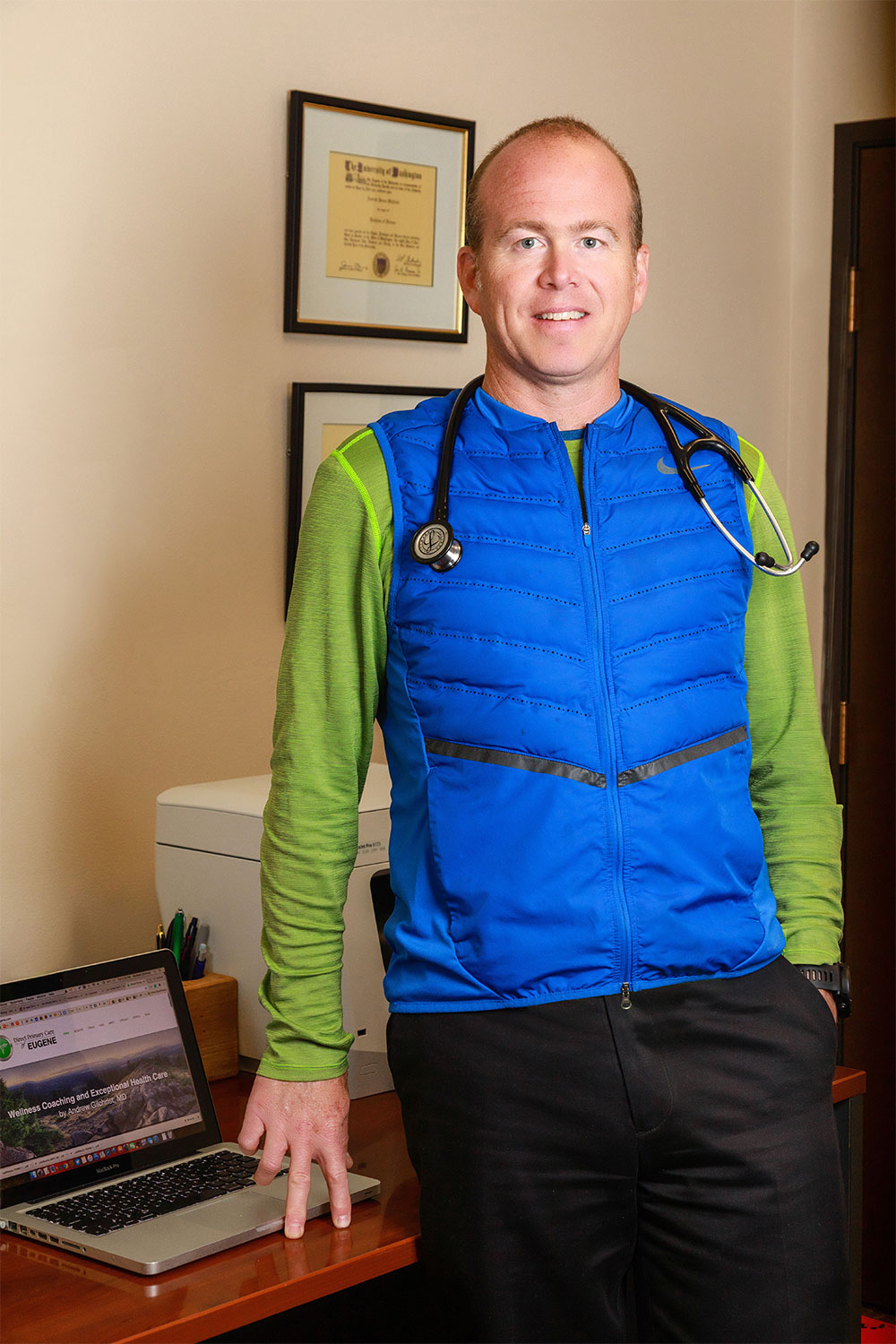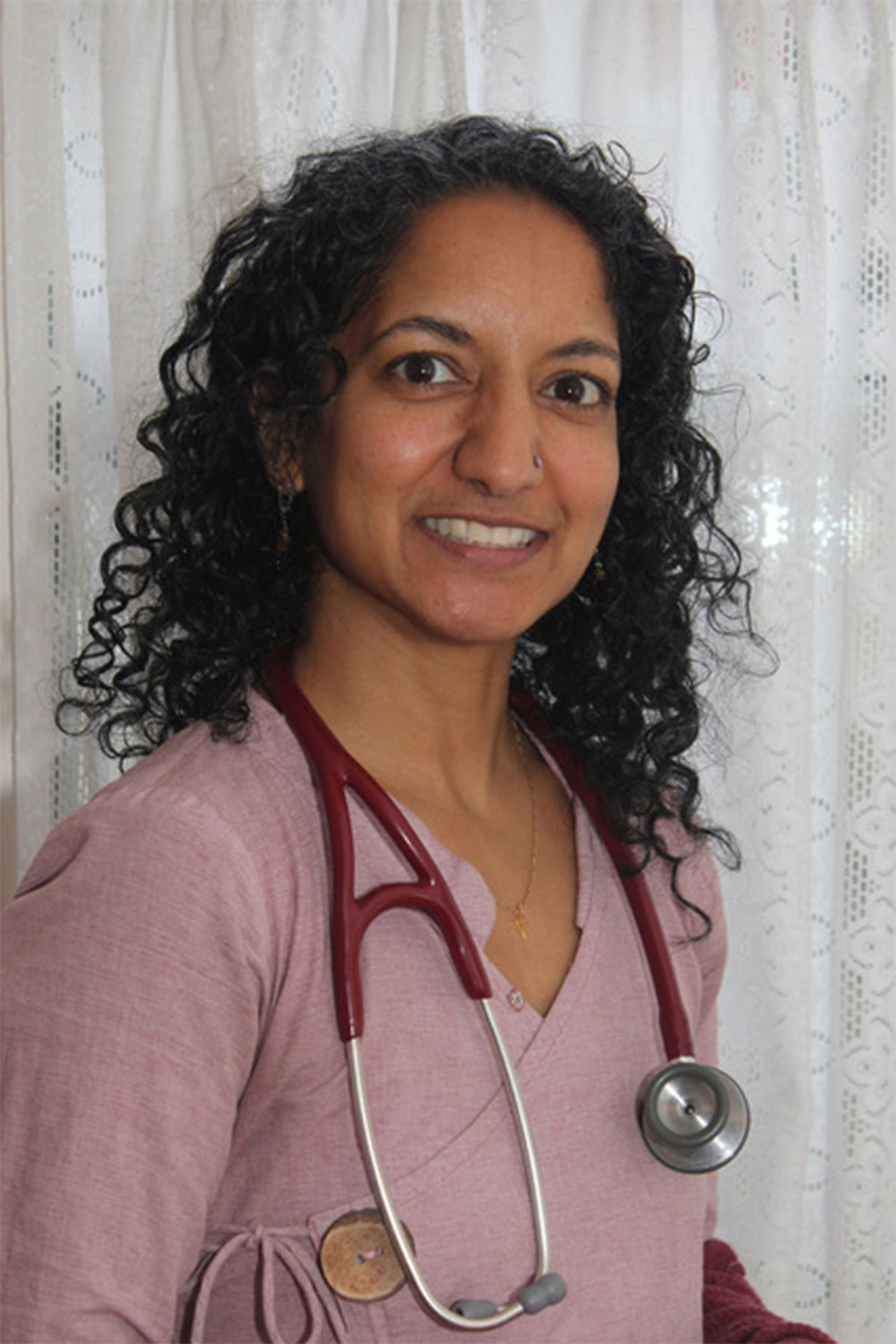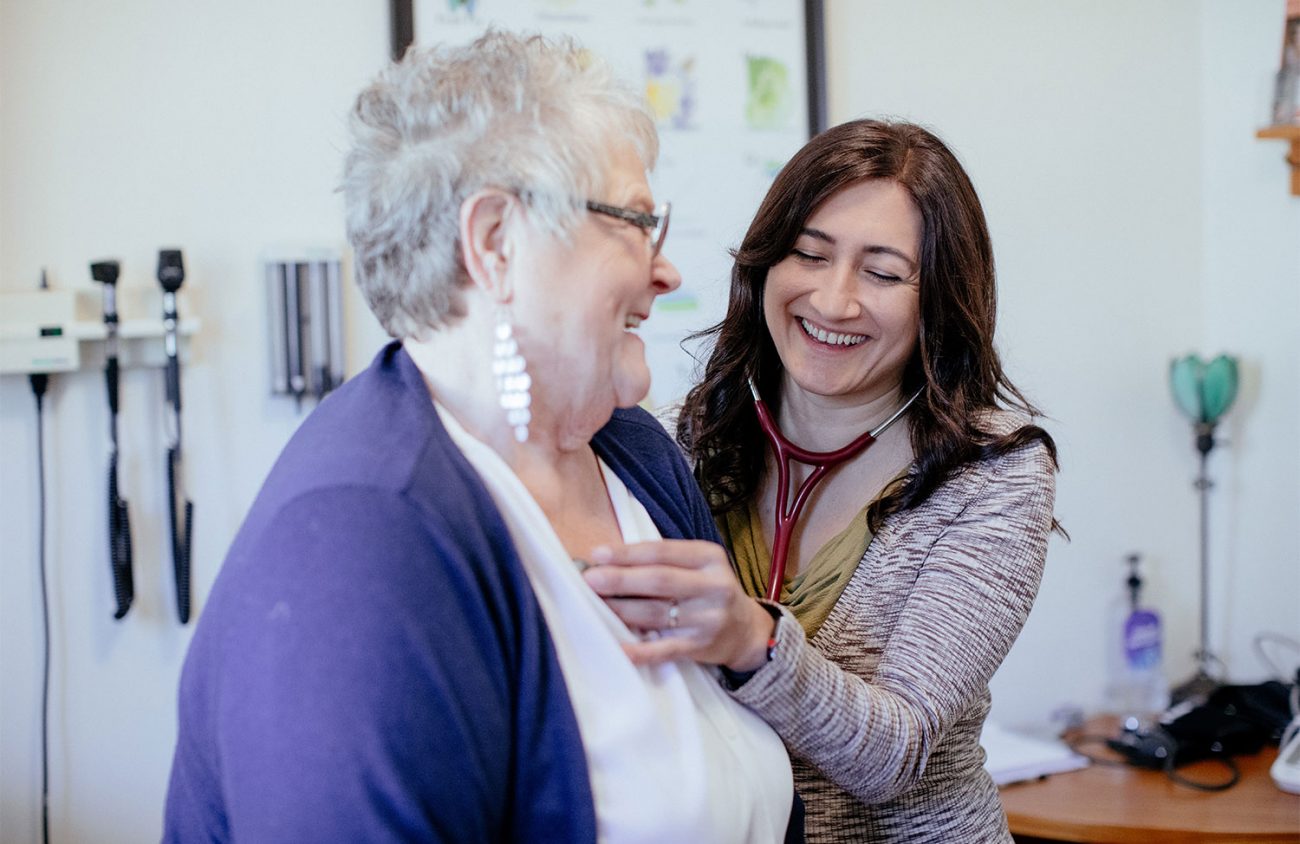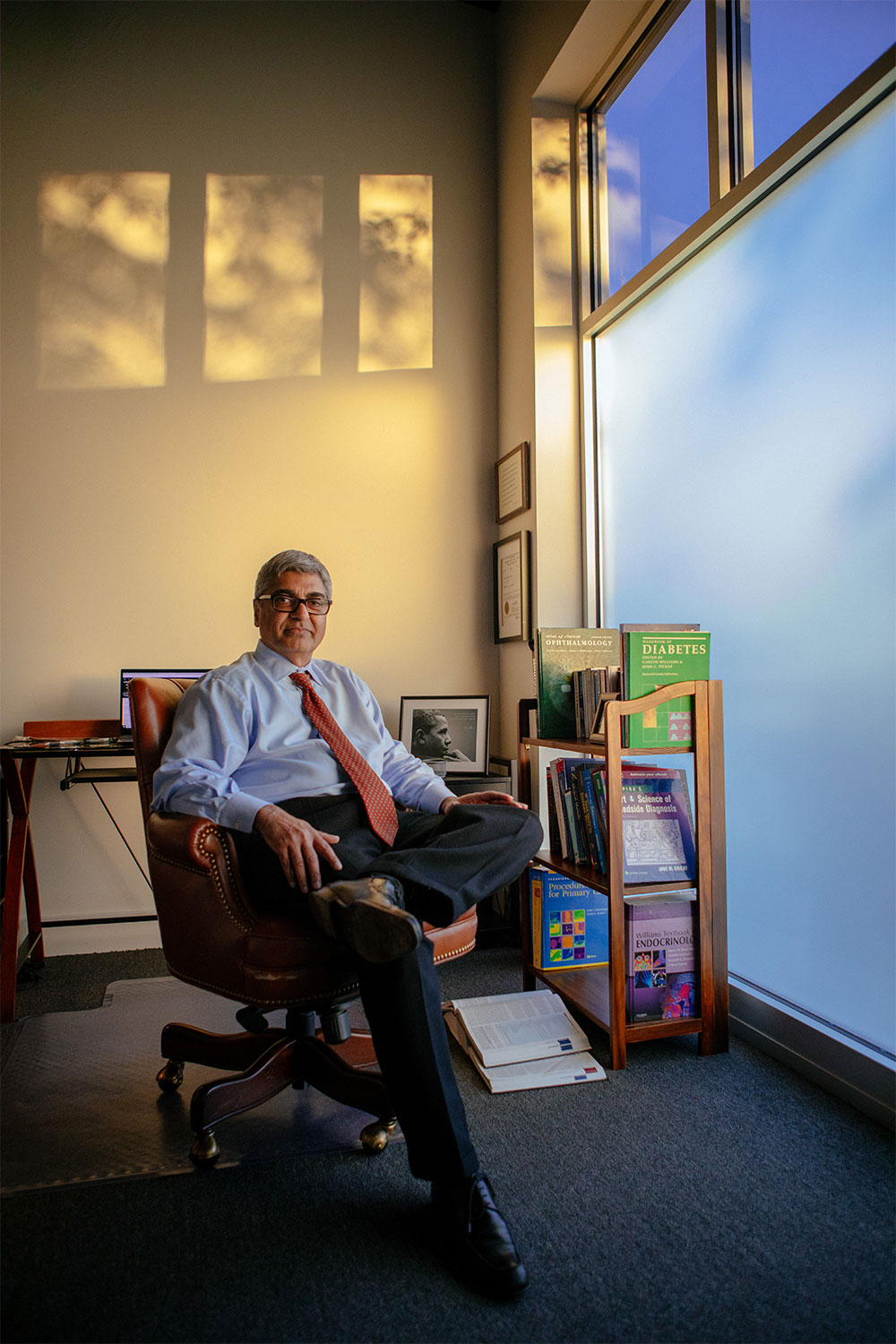Whenever you call Dr. Andrew Gilchrist’s direct primary care (DPC) office, there are no phone trees. There isn’t a receptionist picking up, either. Instead, Gilchrist himself picks up the phone after a few rings.
He opened his DPC office in 2016 and has monthly subscription fees that range from $30 to $120. What that fee buys is longer appointments with Gilchrist, who says he works closely with each patient, creating individualized plans and fostering healthier lifestyles.
“I’ve really tried to focus more on lifestyle medicine rather than getting out the prescription pad,” he says.
One reason he says that patients join a DPC clinic is that they jump through fewer hoops to see the doctor and have direct access to him or her.
Gilchrist is a part of a growing DPC movement that is disrupting the medical field nationally and in Eugene. It’s not thanks to a cutting edge tech app but through spending more time with patients.
Typically, DPC offices strip away overhead that is common in a medical office. By getting rid of tasks such as insurance billing, physicians can charge patients a flat periodic fee and offer all of the primary care provider services.
Patients can visit DPC clinics for physicals, biopsies, access to prescription drugs at wholesale price and more. They have longer appointments and don’t deal with copays.
By stripping medicine to its basics, DPC physicians say they can better understand their patients and avoid sending them to undergo stressful and expensive medical tests. And the physicians are rediscovering their passion to practice medicine again.
Enlarge

Photo courtesy Dr. Gilchrist
A New Hope
Feeling like she wasn’t offering the quality care that she should, Dr. Priya Carden didn’t know whether she could continue working as a physician.
She attended a physician retreat hosted by Dr. Pamela Wible, a Eugene physician who had opened a patient-focused clinic after she had undergone a similar crisis. The retreat brought together physicians to talk about different sorts of practices. Carden entered the retreat skeptical of whether she’d even want to start her own clinic, because medical school doesn’t offer business training. In fact, she says she didn’t even know what the term “LLC” stood for.
Feeling overwhelmed, she says she was considering opening a classical South Indian dance studio instead of her own medical clinic.
But when she heard about the DPC model from a physician in Texas, starting her own clinic sounded doable, she says.
“It didn’t involve swiping the credit card every time a patient contacted me,” she says.
She wouldn’t have to work with health insurance, have a medical biller or deal with insurance codes, she adds.
Back when Carden was considering opening her DPC clinic, the idea was still in its infancy — it didn’t even have a Facebook page where physicians could offer each other support. Today, according to data from Direct Primary Care Coalition, an advocacy group for the model, there are 1,127 DPC practices throughout the U.S.
Carden had to moonlight at a nearby hospital as she worked to establish her practice, and she heard mixed feedback on her professional decision. The nurses there cheered the move, telling her she’d be good at the DPC office. Other doctors, however, doubted her decision.
“Nobody’s gonna pay extra,” she says the doctors told her.
But after only three months she was able to focus her energy on her DPC practice. Today, she has 300 patients and others on a waitlist.
Carden says she offers patients “a medical home,” but not in the way that was imagined by the corporate model that involves insurance billing. She says that DPC practices can offer patients a “medical community.”
Her DPC office offers something close to it.
She says community is what she imagined when she started her practice. She created a “Robin Hood” fund that patients can contribute to so low-income patients can afford to join her practice.
Her “angels and gurus” network brings together her patients to help each other out. This patient network can be matching a patient experiencing a diagnosis that someone has survived or Carden sending an email to all of her patients about how someone might need a helping hand — like picking up medication at the pharmacy.
Carden has about 20 weekly face-to-face appointments, which usually last about 30 minutes, and works about 20 to 30 hours a week. If a patient calls her for an urgent matter, she says she can make a same-day appointment happen.
She says she’s able to spend time reading medical journals if she needs to explore a patient’s condition further — something that you can’t do under the corporate medical model. She even has time to call a specialist if necessary. That means that patients don’t have to undergo unneeded expensive and stressful medical tests.
Since Carden has more time to work with patients, she says being able to listen to patients talk about what they’re experiencing is a way for them to diagnose themselves.
With longer appointments, she says she can actually explain and educate patients about health conditions. She can help a patient make sense of what specialists may have told them about a diagnosis.
Enlarge

Photo courtesy Dr. Carden
Carden was the first physician in Eugene to open a DPC practice, so physicians looking into the model come to her for her insight. She says she’s a naturally positive person, and when she talks about the DPC model, she says she gets even more excited talking with physicians asking about the medical model.
In fact, she says she doesn’t know why a physician would want to stick in the corporate, big box clinic world, aside from the risks associated with starting a new business.
She says she became a hospitalist, a licensed physician who takes care of hospitalized patients, at first because she says she remembers hearing from another physician to not get involved with primary care because it “wasn’t what it used to be.”
But she says more medical students might want to pursue primary care when they hear about the DPC option, which could address an upcoming nationwide primary care provider shortage.
The DPC model doesn’t fix the U.S.’s broken medical system, but it at least “plugs the holes” for her patients, Carden says. And as the country wonders how to deal with its primary care physician shortage, she views the DPC model as a way to attract more physicians to the profession.
It’s at least helped her find a love for practicing medicine again, she says, and she isn’t thinking about opening a dance studio because she’s able to practice the “art of medicine.”
“The physician patient-relationship is sacred,” Carden says. “These connections and the ability to help people navigate through these health care decisions.”
‘A Dream Job’
Dr. Gulrukh Rizvi she says she was feeling frustrated with shortened appointment times with patients while working for a corporate medical group in Eugene.
“It seemed like it was more of a process of referring people, getting their medications, meeting their requirements on the electronic medical record, like filling out forms,” she says. “Patient care was limited to a very brief encounter, and people would have to have repeat visits for other issues we couldn’t address during the visit.”
Patients were feeling frustrated, too, she adds.
Under a time-constrained medical system, you can’t dig into a patient’s mental health situation, family history or what’s going on in someone’s life in a brief appointment, Rizvi says.
Today, she shares an office in Eugene with Carden — a small house downtown on Lincoln Street.
Since Rizvi made the switch to the DPC model, she says she’s able to have conversations and spend more time getting to know a patient’s history.
“People get better faster,” she says. “If they have more access to me, which is my cell phone, email, then I get to hear about things before they become more of an issue.”
Because of the time that Rizvi spends with her patients, she says one patient lost more than 60 pounds thanks to monthly health check-ups, discussions about the book, Obesity Code, and emails with links to articles and videos.
When she was working at a fee-for-service organization, Rizvi wasn’t able to spend this amount of time or be dedicated to the thoroughness with a patient, often having to set another appointment because of time.
Practicing under the DPC model is better for Rizvi because patients aren’t limited to 20-minute appointments where they can only talk about three issues at a time.
When Rizvi found out about the DPC model, she says she was immediately on board. She gave her notice to the organization she was working at and started the paperwork to open her practice.
“This is like a dream job,” she says.
Before shifting to the DPC model, Rizvi thought about leaving medicine.
“I felt I couldn’t do the job I wanted to do. The medicine I was practicing wasn’t true medicine. It was a corporate version of it.”
That’s because 15-, 20- or even seven-minute appointments isn’t enough time to provide the sort of care she wanted to offer — or that’s necessary to improve someone’s health.
“It takes time to heal people.”
At her DPC office, she does the work that medical assistants would normally do. She goes over medications, takes blood pressure levels and other vitals and does all of the intake process herself. There’s no miscommunication that way, she says.
By spending more time with patients, she says she’s experienced more gratitude than when she worked at a corporate medical office.
So every hug, each thank you card she gets from a patient, reminds Rizvi that she made the right decision.
“It feels like I got my calling back instead of doing a job,” she says. “When I take care of people, they feel like they’re being taken care of.”
The Return of the Healer
Dr. Shehzad Jinnah was planning to leave Eugene when he resigned from PeaceHealth after five years as an internist.
He was seeing 16 to 18 patients a day, and because he was dedicated to longer appointments, he would work at least 11-hour days — not including time catching up on work at home.
He says he was encouraged by patients to look into the DPC model rather than move.
“Without them suggesting it, I wouldn’t have done this,” he says. “They didn’t want me to leave town.”
Today, he sees six to seven patients a day at the most.
Subscribing to the service can be costly, but Jinnah says one visit to urgent care or the emergency room for an illness that could have been treated through regular check ups can set someone back financially.
“I know people who have gone to the emergency room for a urinary tract infection and paid $5,000,” he says. “Imagine that person paying $50 a month.”
He adds that people often have to visit the emergency room for reasons stemming from an inability to visit their primary care physician, saying when they’re booked solid it’s hard to fit in last-minute appointments.
The DPC model can offer patients care when they need it to talk about preventative care and continuative care, he says.
“If you have continuative care, you have better quality because your physician knows exactly what’s been happening every visit,” he says.
He goes on to say that a $50 monthly fee is not as much as filling up a gas tank, phone bill or monthly coffee drinks. And the result is that you have near-instant access to a physician who thoroughly knows your medical history.
“If I can avoid one ER visit a year for a patient, that saves a lot of money. By seeing the patient on time, addressing the conditions before they become uncontrollable where the patient suffers,” he says. “A stitch in time saves nine.”
When a patient goes to the doctor with an illness, 80 percent of the time a physician should make a diagnosis by looking at patient history, he says.
That takes time, Jinnah says.
“History is most paramount at making a diagnosis,” he says. “Taking a good history takes good time.”
The cost of not knowing a patient’s history or doing a thorough physical exam sometimes means investigating an illness through more costly methods, he adds, such as expensive tests.
For Jinnah, the cost of switching from corporate medicine to his own DPC office means it’ll take three to five years to recover financially, he says. But the job is worth it.
“Peace of mind, and I have to satisfy my conscience,” he says. “If you compromise on principles, there’s not much left of you, especially in this profession.”
When talking about the medical profession, Jinnah points to the traditional role of a healer. In that time, physicians were healers and patients were the sick; it was a sacred connection. He says the healer had to earn the respect from a patient.
Those roles have all changed, though.
“The healers changed to physicians, and the sick became patients. Now we call physicians ‘providers.’ And the patients, ‘customers,’” he says. “Once the semantics change, the relationships change.”
The DPC model is a way to intervene in the semantics and return to the kind of care physicians that once provided, he adds.
“Medicine is 50 percent art and 50 percent science,” he says. “You have to believe in your physician that he is the person to get you to your goal, whether it’s healing an illness or staying healthy.”
For more information on these direct primary care physicians, visit: Dr. Andrew Gilchrist at DPCEugene.com; Dr. Priya Carden at MapleTreeHealing.com; Dr. Gulrukh Rizvi’s at DocRizvi.com; and Dr. Shehzad Jinnah at JinnahMD.com

